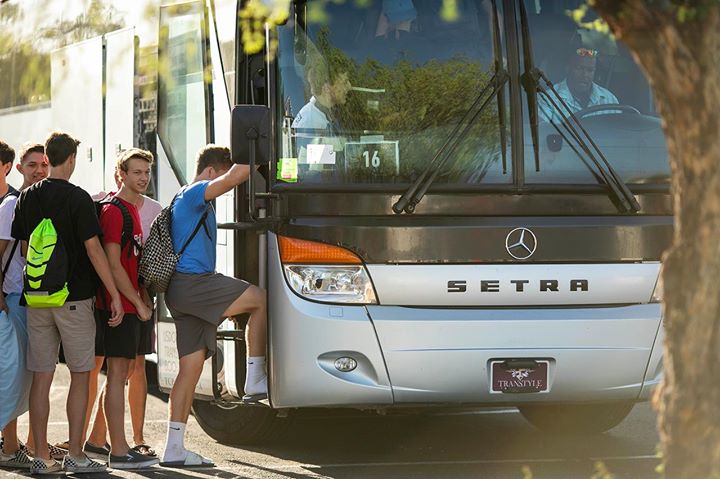Summer Camp Safety
June 26, 2018

@CCVCamp
Yesterday, my wife Rachel and I sent our oldest daughter off to San Diego for a week with CCV Camp. She boarded the bus with hugs and tears, equal parts jubilation and hesitation. She’s going to high school next year and straddling the great divide between childhood and adulthood. She left us with a kiss and a gallon of SPF 50. As a firefighter, my number one goal in everything is safety. I may be overprotective as a result of the trauma I deal with on the job on a regular basis, but my family knows the risks of driving across country, being out in the sun, dehydration, and all the other hidden dangers that can pop up on a trip to camp.
It’s the time of year when 11 million children and young adults across the country head off to summer camp. Here are five things to watch out for when keeping your kids safe while they’re off making memories.
Heat Exhaustion/Stroke
Doctors say it’s easy to get dehydrated in the summer heat, especially if they’re running sports drills or other outdoors activities. Your child’s camp should make sure they drink lots of water and often. The American Academy of Pediatrics says campers should take a break every 20 minutes, and always have water or a sports drink available. Dehydration can lead to heat exhaustion, which can be serious. The Mayo Clinic lists the common symptoms of heat exhaustion as cool, moist skin with goose bumps despite the heat, heavy sweating, faintness or dizziness, nausea and headache. If you experience these symptoms, you should immediately stop your activity, move to a cooler place, and drink cool water or a sports drink. If your symptoms don’t go away within an hour, you should call a doctor.
Heat stroke can happen if heat exhaustion isn’t treated properly. It can happen if your body temperature rises to 104 degrees. Symptoms include confusion, agitation and slurred speech, as well as rapid breathing and heart rate. Heat stroke requires immediate medical attention. If left untreated, doctors say it can result in brain damage or even death.
Water Safety
You don’t have to be at camp to enjoy a day at the pool or lake. Adult supervision is of paramount importance. Nearly 1,000 kids drown each year, with most happening, though, in backyard pools. While at camp, there should be enough adults to adequately keep a watchful eye on all of the campers. Many camps test a child’s swimming abilities at the start of camp, then have them wear a wristband to signal if they can go to the deep end.
The American Academy of Pediatrics says not to use floaties for your children. The group says they only give parents and children a false sense of security. Instead, you should use life vests.
Sunburn
This is a big one in Arizona and California! The American Cancer Society says severe sunburns in childhood can raise a person’s risk for developing skin cancer later in life. While outside, kids and adults should always wear sunscreen with a sun protection factor or SPF of 15. Parents should look for sunscreens that contain zinc oxide or titanium dioxide.
Be sure to reapply the sunscreen after two hours or more often if you’re sweating or you’re in the water. Speaking of being near water, doctors say to use extra caution because the water can reflect the UV rays, causing you to sunburn even more quickly.
In addition to sunscreen, experts say you should send your child to camp with sunglasses and a wide-brimmed hat to protect their eyes from sun exposure.
Bug Bites
Be sure to pack insect repellent in your child’s bag. The American Academy of Pediatrics recommends using products that contain DEET. Also, don’t use a sunscreen/insect repellent combo. That’s because you only apply repellent once, while sunscreen needs to be re-applied every two hours.
While most insect bites are harmless, some do transmit diseases or can be dangerous. Ticks transmit Lyme Disease and Rocky Mountain Spotted Fever. You can get West Nile, Chikungunya Virus from mosquitoes. No location in the U.S. is immune to ticks. They live in grass, trees, shrubs and leaves. If you’re bitten, the most important thing to do is remove it, then clean bite with alcohol or soap and water.
With all of the recent rain, the mosquito population is exploding. To relieve the itch of mosquito bites, the camp counselors may treat your child with a topical anti-itch cream, or an ice pack.
Poison Ivy, Poison Oak or Poison Sumac
Not so much a problem in San Diego, where my daughter went, but an allergic reaction after coming into contact with poison ivy, poison oak, or poison sumac is caused by an oil called urushiol. For some people, the reaction can be very serious, and even life-threatening. The American Academy of Dermatology (AAD) says the people can experience symptoms like trouble breathing or swallowing, swollen eyes, and the rash covers the whole body with blisters. These symptoms require immediate medical attention.
Coming into contact with a poisonous plant can be treated at home or at camp for most people. You should wash the affected area with warm, soapy water, as well as any clothes that came into contact, to get rid of the oil. If any of the oil is left, it can be spread from person to person.
The AAD says you can use calamine lotion or hydrocortisone cream to help relieve the itching; and the group suggests taking an antihistamine to help as well.
Just like sunscreen, experts say there are ivy block products, which prevent the body from absorbing the oil that causes the rash.
References
http://www.mayoclinic.org/diseases-conditions/heat-stroke/basics/risk-factors/con-20032814
https://www.healthychildren.org/English/news/Pages/Summer-Safety-Tips-Staying-Safe-Outdoors.aspx
http://www.healthline.com/health/bug-bites
https://www.aad.org/dermatology-a-to-z/diseases-and-treatments/m—p/poison-ivy/tips